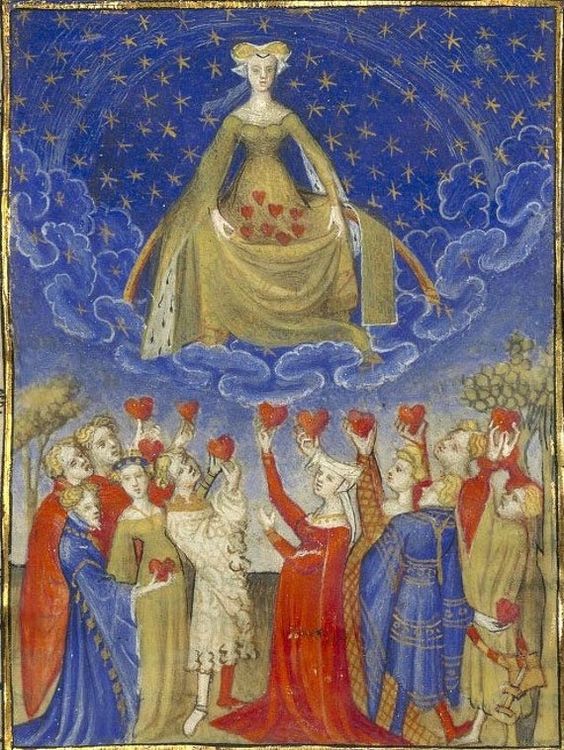
The love of Mary. 15th century illumination by the Master of the Epistle of Othea (Christine de Pisan).
In his work entitled Images de la Vierge, French Catholic philosopher and writer Jean Guitton, member of the French Academy, presents his conception of the fundamental aspects involved in Marian art.
"It is a question of uniting the divine and the human, the virginal, the nuptial, the maternal, - the familiar and the sublime."[1].
The Virgin carries the Eternal, her Creator. She gives Him what is necessary for life: milk, emotions, the words of language...
Eastern art emphasised the coming of the divine through an inverted perspective.
Western art adopted perspective drawing, where the divine irruption transcends this same perspective.
Mary cannot be represented at the Annunciation.
It would require expression of surprise and adoration, jubilation and fear, youth and gravity.
Here, more than ever, we can see that religious art is different from art, because it suggests a vision of faith.
"And you must not know, O you who contemplate, whether you admire these images because of their beauty or because of the mystery that is hidden within them."[2]
Because each of us, in our own culture, is called upon to become spiritually involved, Catholics do not hesitate to place Mary in a Flemish or Japanese landscape... But this should not obscure the realism of the Incarnation: Mary was a Jew from Galilee.
For a long time, the fear of making the female body, even the purest, an object of adoration, and the Oriental idea that women, even in their faces, should remain invisible, prevented art from focusing on the features of the Virgin Mary[3].
But the existence of a completely pure woman, who had given her humanity to God, removed the scruples [linked to the risk of idolatry]. It invited us to contemplate the feminine attitude; it even allowed us to reproduce the hair, the birth of the neck, the feet, the hands, a breast, the face, the look, - to de-paganise the idolised body of the woman. It is the belief in the historical reality of the mother of Jesus that has enabled us to free women from the Oriental harem and reveal her face in broad daylight.
It could even be said that in the West there was a harmony between the type of virgin and the type of woman, which has continued to influence the idea of grooming and decency[4].
Eastern Christians codified their iconography because they emphasised the fact that the Mother of God was unique among all women e.g. the almond-shaped eyes, the design of the lips and the features of the nose were all codified.
Catholics also understand this very well: Jean Guitton writes:
"It is a question of avoiding making Mary be seen as either a young girl or a young mother, common and without mystery..."[5]
But Western Christians also consider that the mother of God reveals the true nature of woman, of every woman. Jean Guitton adds:
"and I dare say that there is no woman in this world who, at certain moments of joy, sorrow, tender adoration, noble familiarity, could not have been a model for a Virgin Mary" [6].
In practical terms, the artist carefully crafts the drawing of her virginal smile and her maternal breast, the breadth of the clothes and their symbolic colours (dark red and blue); he also depicts a sense of peace in suffering (the Passion), a sense of serenity in emotion (various episodes).
Source :
-Jean Guitton, images de la Vierge. Paris: Sun, 1963.
[1] Jean Guitton, Images de la Vierge, Sun, Paris 1963, p. 10.
[2] Ibid, p. 32
[3] In the catacombs, the Virgin is a simple figure, a symbol rather than a portrait; statues from the eleventh or twelfth century are often lifeless.
[4] Jean Guitton, Images de la Vierge, Sun, Paris 1963, p. 6.
[5] Ibid, p. 61.
[6] Ibid, p. 138.
-on the beauty of Maryin the Encyclopédie mariale
-on the Virgin Mary in artin the Marian Encyclopaedia
-on the Annunciation in artin the Marian Encyclopaedia
F. Breynaert et l’équipe de MDN.